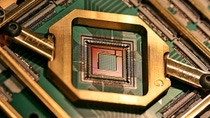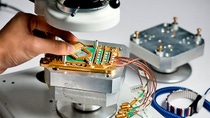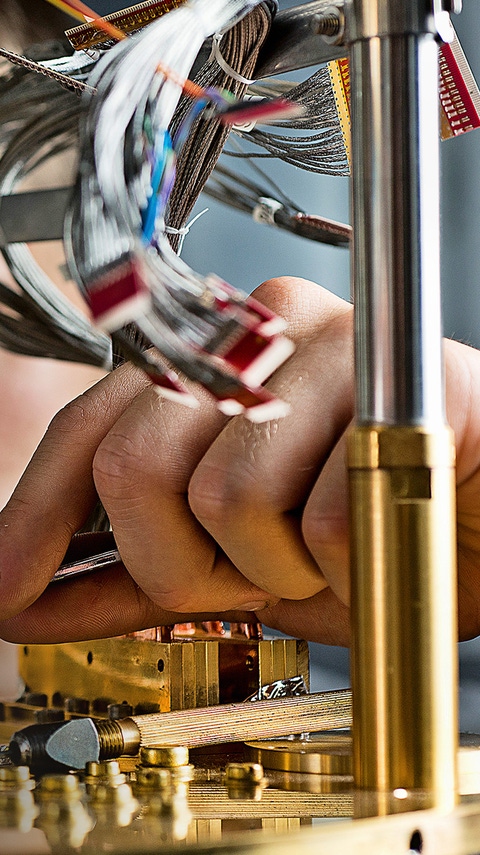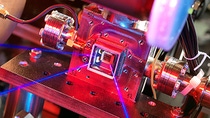€1 billion
that is how much the European Commission is planning to invest in driving progress in quantum technology over the next nine years.
Quantum computers
A shiny, silver cylinder holds the treasure: qubits, frozen by a helium pump to minus 273 degrees Celsius. These are the building blocks that enable quantum computers to work, because, unlike the bits in a classical computer, qubits can store and process two states simultaneously.
This new computer logic is intended to make them much faster than any supercomputer, and their search for new products, applications or patterns more efficient. The disadvantage is that qubits are extremely volatile. They function in a stable, fault-free manner only if there are no external influences. To ensure this, they have to be not merely frozen but also shielded from the outside world in a vacuum.
Fragile super brains
Efforts to crack this problem are still in the initial stages. To date, researchers have developed fully programmable five-qubit computers and more fragile 10 to 20-qubit test systems. For example, in May 2017, IBM presented a processor with 17 qubits, which is intended to form the foundation of the first commercially available quantum computer.

Quantum computers are more or less at the same stage as classical computers were in the 1940s“
“We’re progressing faster and faster,” says IBM researcher Anthony Annunziata, PhD, from the United States. Now, he notes, the IBM system is stable enough to perform computing operations over a fairly long period. But Annunziata warns that the technology is still at a very early stage. “Quantum computers are more or less at the same stage as classical computers were in the 1940s, but they are developing even more rapidly than classical computers did back then,” he says.
It is only when we reach around 30 to 50 qubits that a quantum computer would be superior to any conventional supercomputer in solving a specific problem, in the view of experts such as Professor Raymond Laflamme, Director of the Institute for Quantum Computing at the University of Waterloo in Canada. “But if we extrapolate the trend of the last 15 years, 100 qubits are conceivable within the next 10 years,” says the pioneer in quantum computing. The Massachusetts Institute of Technology predicts that a fundamental breakthrough for quantum computers could well be made within four to five years. Whether it is IBM, Google, Microsoft or Intel, none of the big tech companies is afraid of the high cost involved in developing a powerful quantum computer – to say nothing of secret services like the U.S. NSA, which are probably working “under the radar” on powerful quantum systems to crack encrypted communications.

Quantum computers bring impetus
This is because Moore’s Law, according to which the power of computer chips will double every one to two years, is now getting close to its technological limits. Experts believe that a breakthrough in quantum computers could provide a fresh impetus. According to Laflamme, six to seven teams worldwide are currently engaged in research to achieve this goal, and billions are being spent in the process. For example, the European Commission is planning to invest €1 billion in driving progress in quantum technology over the next nine years. Also, China made headlines in August 2017 with the news that a satellite had shared a quantum key with a ground station for the first time – a milestone on the road to virtually unhackable encryption through quantum technology. However, “for the foreseeable future, quantum computers won’t surpass or even substitute supercomputers across the board,” Annunziata says. “They will act as a supplement, for the solution of very special problems.” They are ideally suited to represent dynamics in molecules and thus to show, for example, how one electron interacts with another and with the nucleus. “If the number of electronic states increases, the number of possible interactions increases exponentially. As conventional computers can’t represent that properly, they try with approximations,” he says. A quantum computer, meanwhile, is already using quantum mechanics, the kind of mechanisms that are also at work in molecular interactions.
How quantum computers are unique
Benefits for research
Several sectors can benefit from the greater precision of modeling, such as materials sciences and the chemical or pharmaceutical industries, Laflamme says. Researchers can use the disadvantage of quantum particles – their sensitivity – to their advantage here, for example in prospecting for natural resources or diagnosing illnesses. For instance, qubits are already being deployed as super-sensitive sensors that can precisely detect individual atoms of defective proteins that might turn cancerous. To do this, they focus very closely on the vibrations of one specific atom.
Currently, though, the main priority is to increase the number of people who want to understand and use quantum computers, Annunziata says. This is why IBM made its quantum computer accessible to the public about a year ago. Since then, 50,000 users have accessed the Quantum Experience platform. Through the open source approach, it is possible to learn from and with the community, Annunziata says. According to media reports, Google’s parent company Alphabet has recently followed suit with its quantum computer and is planning to open it to academics and developers. This may result in the emergence of a kind of ecosystem, in which the discipline of “quantum computing” is able to flourish.



